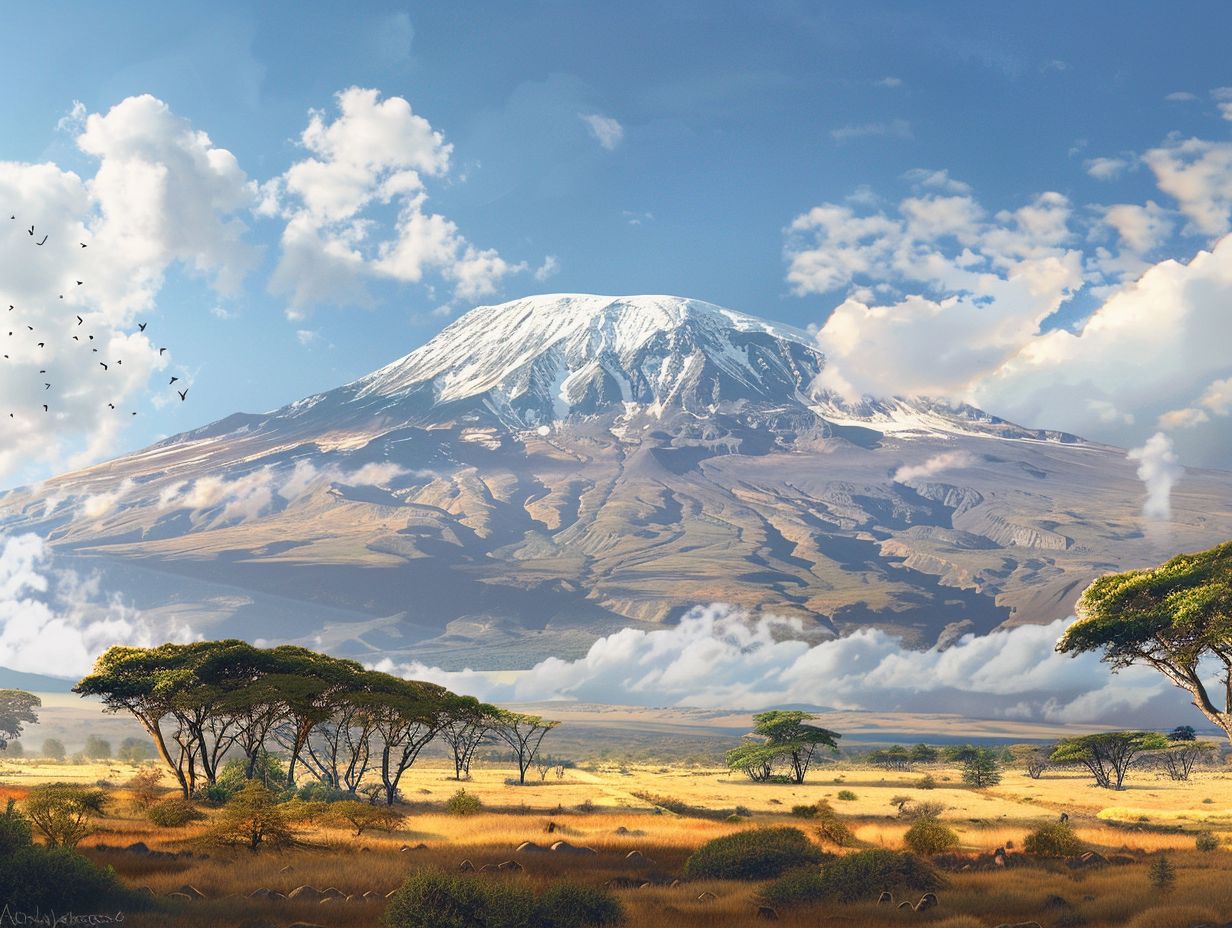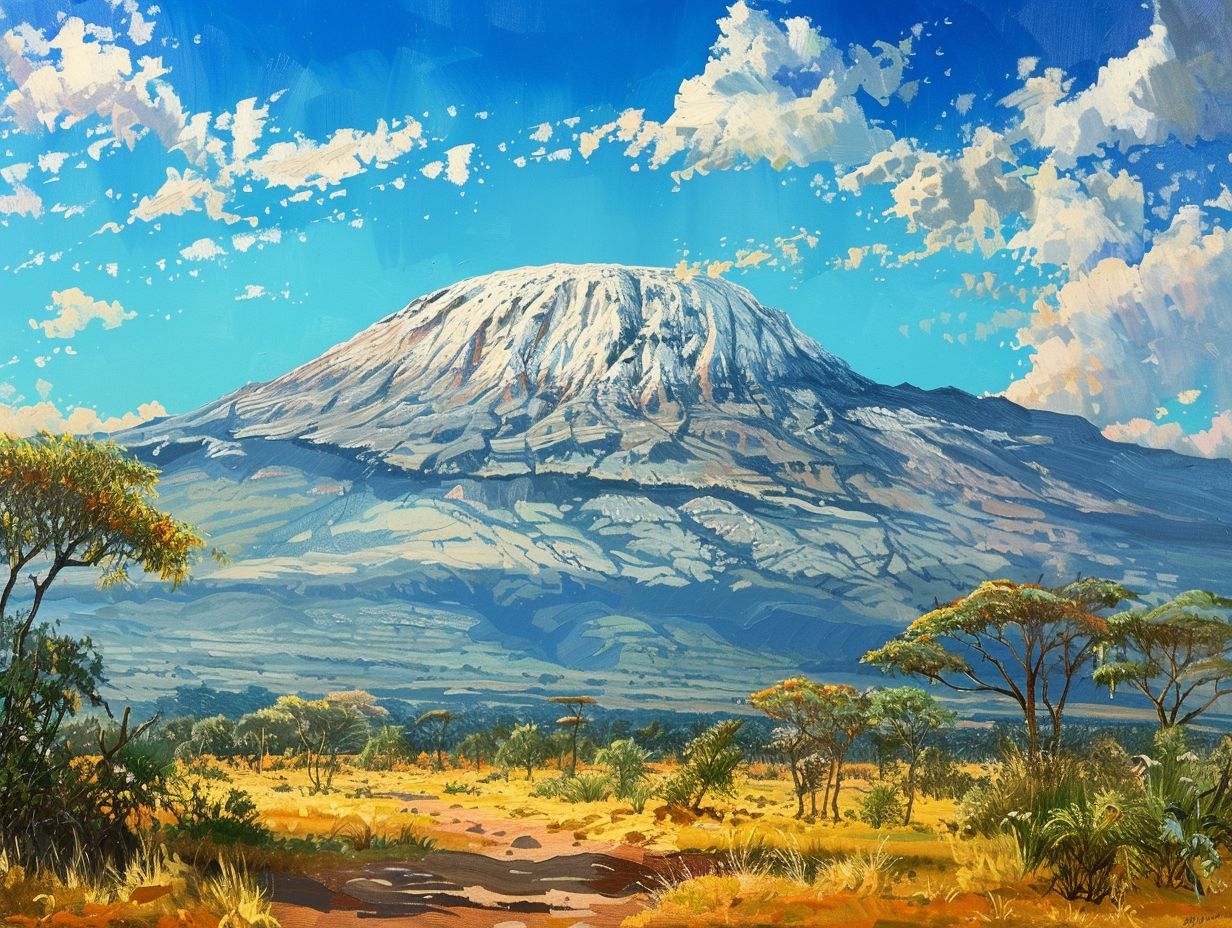
Have you ever wondered about the mysteries of volcanoes and their impact on the world around us?
In this article, we will explore the fascinating world of volcanoes, focusing on the iconic Mount Kilimanjaro. From its formation to historical eruptions and the latest scientific findings, join us on a journey to uncover the secrets of this majestic peak.
Discover whether Mount Kilimanjaro is currently active and what the future may hold for this natural wonder.
Key Takeaways:

- Mount Kilimanjaro is a dormant volcano located in Tanzania, Africa, and has not erupted in over 360,000 years.
- The last known eruption of Mount Kilimanjaro occurred over 360,000 years ago, based on scientific studies and evidence.
- While Mount Kilimanjaro is currently inactive, it is constantly monitored for potential future eruptions, which could have a significant impact on the surrounding area.
Has Mount Kilimanjaro Erupted Before?
Mount Kilimanjaro has a history of volcanic eruptions, with evidence of past eruptions scattered across its slopes. Studying these historical eruptions provides valuable insights into the volcano’s behavior and helps researchers understand the potential risks associated with future volcanic activity.
The geological records show that Mount Kilimanjaro has experienced several major eruptions in the past, shaping its landscape and leaving distinctive volcanic deposits. These eruptions have not only influenced the physical features of the volcano but also impacted the surrounding ecosystems and local communities.
By analyzing these volcanic events, scientists can decipher patterns in the volcano’s activity, which aids in forecasting potential eruptions, implementing early warning systems, and devising strategies for mitigating volcanic hazards.
Evidence of Past Eruptions
Evidence of past eruptions on Mount Kilimanjaro can be identified through various means such as seismic monitoring, analysis of lava flows, seismometer data, and the occurrence of rockfalls. These indicators offer valuable insights into the volcanic history and behavior of the mountain.
Seismic monitoring involves the use of specialized instruments to detect and record the seismic waves generated by volcanic activity. By analyzing the frequency, amplitude, and location of these waves, scientists can pinpoint areas of increased volcanic activity.
Similarly, studying lava flows provides a direct physical record of past eruptions, allowing geologists to determine the eruption style, duration, and volume of magma involved.
Seismometers play a crucial role in monitoring the long-term seismic activity of Kilimanjaro, helping to assess the volcano’s current state of unrest.
The observation of rockfalls offers insights into the destabilization of volcanic slopes and the potential hazards posed by such events.
When Was the Last Eruption of Mount Kilimanjaro?
The last eruption of Mount Kilimanjaro was a focus of scientific studies aimed at understanding its impact on the surrounding environment. The findings shed light on the repercussions of the volcanic activity and the measures needed to mitigate any adverse effects.
Scientific research conducted following the eruption delved into various aspects, including the composition of the volcanic ash and its effects on soil fertility. Studies indicated that the ash contained minerals beneficial for plant growth.
The rapid accumulation posed threats to local vegetation, requiring prompt attention. Researchers also analyzed the impact on wildlife habitats, revealing disruptions in animal migration patterns and habitat degradation.
The ecosystem faced challenges in recovering from the upheaval caused by the eruption.”
Scientific Studies and Findings
Scientific studies on the last eruption of Mount Kilimanjaro delved into the geology of the region, the presence of magma chambers beneath the surface, and seismically detected rockfalls. These findings provide crucial data for understanding the volcanic processes at play.
Mount Kilimanjaro, the highest peak in Africa, is a majestic stratovolcano composed of layers of lava flows, volcanic ash, and rocks that reveal a complex geological history. The magma chambers deep within the earth’s crust act as reservoirs of molten rock that fuel volcanic activities.
These chambers play a significant role in the eruption dynamics of Kilimanjaro, influencing the type and intensity of volcanic events. Seismically detected rockfalls on the mountain serve as early warning signs of potential eruptions, offering valuable insights into the evolving volcanic behavior.
Impact of the Last Eruption

The last eruption of Mount Kilimanjaro had a significant impact on its environment, leading to glacier retreat and posing challenges to conservation efforts in the region. Understanding the environmental consequences of volcanic eruptions is essential for preserving the natural beauty of the mountain.
Volcanic eruptions on Mount Kilimanjaro have accelerated the melting of its glaciers, altering the landscape and threatening the delicate ecosystem. The retreat of glaciers not only affects the mountain’s aesthetic appeal but also impacts the water resources and biodiversity of the surrounding areas.
Conservation initiatives play a crucial role in monitoring and protecting the environment against the aftermath of volcanic activities. By implementing sustainable practices and raising awareness about the importance of environmental conservation, we can work towards safeguarding the natural heritage of Mount Kilimanjaro for future generations.
Is Mount Kilimanjaro Currently Active?
The current status of Mount Kilimanjaro’s volcanic activity is closely monitored to predict any potential eruptions in the future. Continuous monitoring allows scientists to assess the risks associated with volcanic activities and take necessary precautions to safeguard the surrounding areas.
Scientists utilize a variety of tools and techniques to keep a watchful eye on Kilimanjaro’s volcanic behavior. Seismic monitoring stations strategically placed around the mountain track any underground movements that could indicate volcanic unrest. Satellite imagery helps in monitoring any surface changes such as bulging or deformation of the terrain, which may signify increased volcanic activity.
Volcanic risk assessment involves analyzing historical data, eruption patterns, and the current geological composition of the mountain to better understand the potential scenarios for future volcanic events.
By studying these factors comprehensively, scientists can develop forecasts and early warning systems that enable authorities to mitigate risks and protect local communities from potential volcanic hazards.
Monitoring and Predicting Activity
The monitoring of Mount Kilimanjaro involves tracking tectonic plate movements, seismically detected rockfalls, and assessing the economic value of the region. These factors play a crucial role in predicting volcanic activities and ensuring the safety of nearby communities.
Tracking tectonic plate movements is primarily done through GPS stations positioned around the volcano, measuring small shifts in the Earth’s crust that could indicate rising magma beneath. Seismometers are strategically placed to detect rockfalls and seismic tremors, providing crucial data on potential eruptions.
Understanding the economic value of the region involves assessing not just the cost of potential damages from an eruption but also the tourism revenue generated by the allure of this volcanic wonder. The investment in proper monitoring systems far outweighs the costs incurred in case of an unanticipated volcanic event.
Potential for Future Eruptions
Assessing the potential for future eruptions on Mount Kilimanjaro involves analyzing factors such as ash accumulation, soil erosion, and the condition of the summit crater. Understanding these elements is vital for predicting and preparing for any volcanic events that may occur in the future.
Various indicators play a crucial role in determining the likelihood of an eruption. Ash accumulation can lead to increased pressure within the volcano, indicating potential activity. Soil erosion, caused by previous eruptions or environmental factors, can weaken the stability of the slopes, potentially triggering events.
Monitoring the summit crater’s condition, including thermal and gas emissions, provides insights into the volcano’s internal activity. This data is invaluable for scientists in assessing the volcano’s current state and making informed predictions about its future behavior.
Conclusion: The Future of Mount Kilimanjaro
The future of Mount Kilimanjaro hinges on sustainable conservation efforts, responsible tourism activities, and the preservation of its status as a UNESCO World Heritage site. The mountain’s allure to climbers worldwide underscores the need for collaborative initiatives to protect this natural treasure.
Being the tallest peak in Africa, Mount Kilimanjaro not only offers a challenge to climbers but also serves as a critical ecosystem supporting diverse plant and animal species. The impact of climate change poses a significant threat to the mountain’s glaciers, emphasizing the urgency for effective conservation measures.
By promoting sustainable tourism practices, visitors can enjoy the breathtaking beauty of Kilimanjaro while ensuring its long-term preservation. As a UNESCO World Heritage site, Kilimanjaro embodies cultural and natural significance, making its protection a global responsibility.
Final Thoughts and Recommendations

As Mount Kilimanjaro stands as a beacon of geological history and natural beauty, it is imperative to prioritize conservation efforts in the face of potential volcanic eruptions.
The majestic peak of Mount Kilimanjaro not only captivates with its snow-capped summit but also houses a delicate ecosystem that is vulnerable to the aftermath of volcanic activity. The dramatic landscape, with its diverse flora and fauna, is intricately intertwined with the harsh realities of geological forces that shape the earth.
The significance of preserving this UNESCO World Heritage Site goes beyond its aesthetic appeal; it speaks to our responsibility in mitigating environmental risks.
Through diligent seismic monitoring and scientific advancements, we can anticipate and prepare for any seismic disturbances that might threaten the stability and well-being of this natural wonder, ensuring its continued legacy for generations to come.
Frequently Asked Questions
When Was The Last Time Mount Kilimanjaro Erupted?
The last known eruption of Mount Kilimanjaro occurred over 200 years ago in 1887.
How Often Does Mount Kilimanjaro Erupt?
Historically, Mount Kilimanjaro has had major eruptions approximately every 200-300 years.
Is Mount Kilimanjaro Considered Active?
No, Mount Kilimanjaro is not currently considered an active volcano. However, it is still classified as a dormant volcano.
What Type of Eruptions Does Mount Kilimanjaro Have?
The eruptions of Mount Kilimanjaro are generally explosive and can produce ash, lava, and pyroclastic flows.
Are There Any Signs of Mount Kilimanjaro Erupting Soon?
Currently, there are no signs or indications that Mount Kilimanjaro will erupt in the near future.
How Safe is it to Hike Mount Kilimanjaro?
Despite its dormant status, Mount Kilimanjaro is generally considered safe for hikers. However, it is important to follow proper safety precautions and guidelines when trekking.